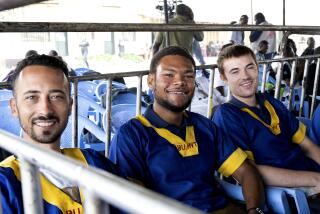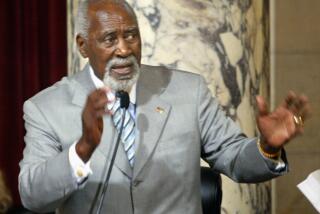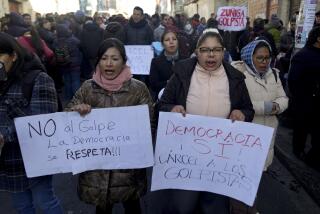The ultimate fake-out
BOGOTA, COLOMBIA — A fake humanitarian organization was created, complete with a special logo and a website. Bogus messages circulated through the jungle on tiny computer drives. Commandos aboard a helicopter posed as a doctor, a nurse, news reporters and cameramen.
For several weeks Colombian armed forces constructed a fake universe, and with help from U.S. intelligence and equipment, managed to fool the Revolutionary Armed Forces of Colombia insurgent group into giving up 15 hostages Wednesday, including former senator and presidential candidate Ingrid Betancourt and three U.S. defense contractors.
New information emerged Thursday that may explain how the rebels were tricked into gathering the hostages at one remote jungle location and putting them aboard a helicopter that supposedly was headed for a special meeting with the new FARC commander, Alfonso Cano.
Many details remain unknown, but the deception apparently depended on the rebels having a degree of comfort with outside helicopters and personnel who had entered secret locations without posing any threat. Colombian and U.S. officials say there was no reason for the rebel commander guarding the hostages to disbelieve the “orders” that seemed to come from his superiors.
So daring was the plan hatched by two Colombian colonels that when they brought it to commanders in April, Defense Minister Juan Manuel Santos exclaimed, “Are these people crazy?”
The risks were high: one U.S. official gave it only a 50% chance of success.
Had the operation failed, the United States was prepared to participate in a “Plan B,” which would have sent, within 15 minutes, 2,000 Colombian troops and U.S. advisors aboard 39 helicopters to within half a mile of the site.
The Colombian military chief of staff, Gen. Freddy Padilla said Thursday, “On the morning of the operation, I prayed to the memory of my mother, to whom I have never asked anything, to grant success and for there not to be anyone killed.”
Padilla said the rescue plan succeeded because Colombian army intelligence agents had infiltrated the inner circle of both the FARC’s governing secretariat as well as the rebel unit led by Gerardo Aguilar Ramirez, alias Cesar, who was in charge of guarding the high-value hostages.
The rescue was planned and executed by the Colombians, and benefited from equipment, intelligence and years of training from the United States government. About 100 full time employees at the U.S. Embassy here have been working on freeing the hostages from the United States -- Marc Gonsalves, Thomas Howes and Keith Stansell -- since February 2003. They were taken captive after their drug surveillance plane crash-landed in the jungle. A fourth colleague was killed.
U.S. help included surveillance cameras that were placed along rivers the rebels were known to traverse. The U.S. also provided satellite imagery and the technology that helped the Colombians locate the rebels. The decision to go ahead with the mission went all the way to President Bush, who in recent days gave his approval, a U.S. government source said
“We have been training, equipping and embedding people in preparation for a rescue operation for 5 1/2 years,” U.S. Ambassador William Brownfield said in an interview Thursday.
At the embassy, euphoria prevailed and the lobby that had long featured photos of the three hostages now had celebratory champagne bottles and beer cans.
According to recent rebel deserters, the FARC command has become increasingly isolated as its radio, cellphone and satellite phone communications have been compromised by listening equipment provided by the U.S., Padilla said.
“Because of the rebels’ command and control problems, they have had to resort to medieval communication methods such as human couriers,” he said.
Having undercover agents in place in the FARC command made it possible to use pen drives and floppy disks to send bogus messages to the leadership. Those fake messages ultimately fooled Cesar into putting the hostages aboard the helicopter Wednesday.
Cesar also was duped into aggregating three separate groups of hostages and then transporting them to La Paz, a six-week trip 110 miles northeast of where they were being held near the Apaporis River in southeastern Guaviare state.
The rebels apparently thought that they and the hostages were being taken to a meeting with the new FARC commander, who took over from founder Pedro Antonio Marin, alias Manuel Marulanda, who died in March.
A phony organization called the International Humanitarian Group was in charge of the helicopter, which bore its logo. Colombian and U.S. intelligence officials even created a fake website in case rebel commanders checked.
Betancourt told reporters Wednesday that she was infuriated when she saw the chopper and its crew, some of whom were wearing Che Guevara T-shirts, because she thought the hostages were going to be used for some publicity stunt.
She and the other hostages were also upset about being handcuffed, which Padilla said was a precaution to prevent the hostages from trying to hijack the helicopter that would prove to be their salvation.
Once airborne at 2,500 feet, the eight Colombian commandos who were on board the chopper in various guises, including news reporter, cameraman, doctor and nurse, overcame and disarmed Cesar and another FARC commander.
One U.S. official said that great care was taken to make the rented Russian-made MI-17 helicopter and its crew resemble those that Venezuelan President Hugo Chavez sent with Red Cross officials to the area in January and February to recover six FARC hostages.
To put the rebels’ minds at ease, two commandos posed as video reporters much like the Telesur team that Chavez sent to record the earlier releases.
Colombia almost launched a rescue operation in February after the three Americans were seen bathing in the Apaporis River. But before an operation could be launched, the hostages and their captors slipped into the jungle.
That rescue plan did not involve a ruse but a rapid deployment “humanitarian cordon” that was to have been airlifted to encircle the rebel camp.
A rescue plan moved back to the front burner in May after Colombian authorities again located the hostages in southeast Guaviare, based on intelligence gleaned from FARC deserters and army officer Jhon Frank Pinchao, a former hostage who escaped the FARC in May 2007.
The two colonels who devised the “bottom up” plan will be decorated, Padilla said. He declined to disclose their identities.
“I never dreamed this could happen,” the general said, “which is not to say I didn’t want it to.”
--
--
Times staff writer Patrick J. McDonnell contributed to this report.
More to Read
Sign up for Essential California
The most important California stories and recommendations in your inbox every morning.
You may occasionally receive promotional content from the Los Angeles Times.










